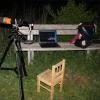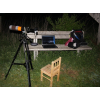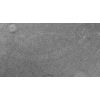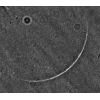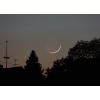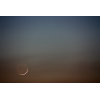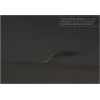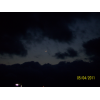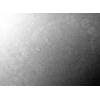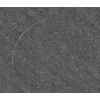نتائج رصد هلال جمادى الآخرة لعام 1432 هـ
- توقع رؤية هلال أول الشهر (جمادى الآخرة)
- نتائج تحري هلال أول الشهر (جمادى الآخرة)
- بداية الشهر الرسمية
- توقع رؤية هلال آخر الشهر (جمادى الأولى)
- نتائج تحري هلال آخر الشهر (جمادى الأولى)
توقع رؤية هلال أول الشهر (جمادى الآخرة)
سيحدث الاقتران المركزي (المحاق المركزي) يوم الثلاثاء 03 آيار / مايو 2011 في الساعة 06:51 بالتوقيت العالمي بمشيئة الله
إمكانية رؤية الهلال يوم الثلاثاء 03 آيار / مايو 2011 ويوم الأربعاء 04 آيار / مايو 2011 موضحة في الأشكال التالية باستخدام برنامج المواقيت الدقيقة باعتماد معيار عودة، بحيث:-
- رؤية الهلال مستحيلة من المناطق الواقعة في اللون الأحمر بسبب غروب القمر قبل غروب الشمس أو/و بسبب حصول الاقتران السطحي بعد غروب الشمس.
- رؤية الهلال ممكنة باستخدام التلسكوب فقط من المناطق الواقعة في اللون الأزرق.
- رؤية الهلال ممكنة باستخدام التلسكوب من المناطق الواقعة في اللون الزهري، ومن الممكن رؤية الهلال بالعين المجردة في حالة صفاء الغلاف الجوي التام والرصد من قبل راصد متمرس.
- رؤية الهلال ممكنة بالعين المجردة من المناطق الواقعة في اللون الأخضر.
- رؤية الهلال غير ممكنة بالعين المجردة أو بالتلسكوب من المناطق غير الملونة، على الرغم من غروب القمر بعد غروب الشمس ومن حصول الاقتران السطحي قبل غروب الشمس، وذلك بسبب قلة إضاءة الهلال و/أو بسبب قربه من الأفق.
- يرجى ملاحظة أن الأشكال أدناه تبين إمكانية رؤية الهلال في المناطق الواقعة بين خطي عرض 60 شمالا و60 جنوبا.
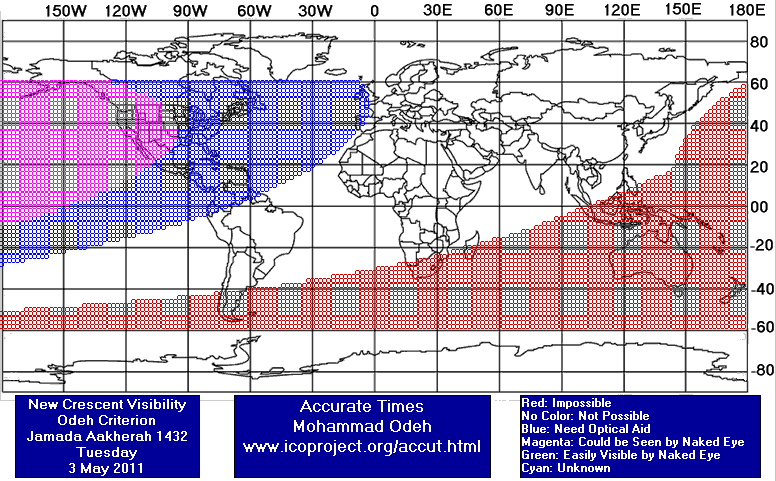
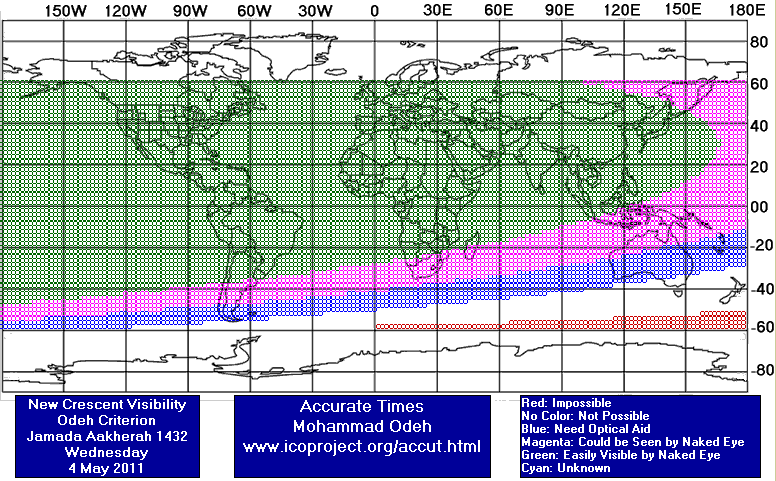
باعتماد التقويم الهجري العالمي المبني على حساب إمكانية رؤية الهلال، فإن بداية الشهر في النطاق الشرقي تكون يوم الأربعاء 04 آيار / مايو 2011 ، وبداية الشهر في النطاق الغربي تكون يوم الأربعاء 04 آيار / مايو 2011 . الرجاء ملاحظة أن التقويم الهجري العالمي يعتمد على الحسابات المسبقة ( اي لا ينتظر الرصد العملي و رؤية الهلال ) و هو يتبنى معياراً معينا لبدء الشهر الهجري الجديد .و قد تتبنى بلدك او منظمتك معياراً آخر لبدء الشهر لذا فإننا ننصح و بشدة أن يتم الاطلاع عما جاء في صفحة التقويم الهجري العالمي في موقعنا قبل إصدار اي أحكام .
ستضاف نتائج تحري الهلال وبداية الشهر الرسمية في مختلف الدول الإسلامية في هذه الصفحة إن شاء الله فور استلام نتائج الرصد من قبل أعضاء المشروع الإسلامي لرصد الأهلة.
نتائج تحري هلال أول الشهر (جمادى الآخرة)
الثلاثاء 03 مايو 2011
الجزائر
وقال عضو المشروع السيد حسين الشيخ عيسى "(12) persons were present in N'tissa station and have tried to observe the Jumada II 1432 crescent but it wasn't seen. The western horizon was supreb after rain. They have used one binocular : 50x7"
ألمانيا
وقال عضو المشروع المهندس مارتن إليسياسر "I gave it a try with the imaging equipment from a local site, but could only carry a small lens with tripod. Weather conditions were very hazy near the horizon (at only 5°C, clouds from day-long rain just moving away) and i was not sure enough of the position. I tried scanning back and forth across the assumed path of the crescent for 30 minutes but could NOT see the crescent on the screen, nor find it in the saved images later. At only 5.5° of elongation it takes better weather and better preparation."
المملكة المتحدة
وقال عضو المشروع المهندس قمر الدين "On Tuesday 3 May 2011 (29 Jumada Al-Ula 1432 AH) many people from throughout UK have attempted to sight the crescent moon (Hilal) of Jumada Al-Ukhra (or Jumada Al-Thani) after sunset. None of the groups were able to sight the Hilal, even though some places had clear sky conditions. We have not received any reliable sighting news from countries east of UK or Morocco either. Fax received from Morocco Awqaf Ministry had negative sighting reports from all 278 points within the entire country. Therefore, the Ulama (including Wifaq/Batley) have decided that the month of Jumada Al-Ula 1432 AH will complete 30 days and the month of Jumada Al-Ukhra 1432 AH will start from Thursday 5 May 2011, Insha-Allah."
الولايات المتحدة
وقال عضو المشروع الدكتور جواد تورابنيجاد "This evening (Tuesday, May 03, 2011), the sky was totally cloudy in Blacksburg, VA, and thus there was no chance of sighting the crescent."
وقال عضو المشروع الدكتور جون كالدويل "43 min lag, some cloud bands but "clear" bands too, surprised not to see it in binoculars, did not look like so bad conditions, even saw multiple very distant airplane trails near that horizon"
وقال عضو المشروع السيد جيم ستام "Observed: Tuesday; May 03, 2011 - 19:18 (Local). Location (WGS 84) = Tucson, Arizona (USA). Longitude = 110.9651 W. Latitude = 32.4206 N. Elevation = 842 meters. Time Zone = -7.0 hours. Surface conditions at location: Temperature = 26 °C. Humidity = 5 %. Pressure = 29.85 in.A few clouds near the horizon, but none interfering. Topocentric and local time values from “Accurate Times”: Sunset (at sea level) = 19:11. Moonset (at sea level) = 19:57. Time from new moon at 19:32 = 19 hr. 13 min. Moon lag time = 46 min. Relative Altitude = 8.7 degrees. Elongation from sun = 8.7 degrees. Crescent width = 10 arc seconds. Illumination = 0.6 percent. Crescent first observed through 8” SC telescope: Time = 19:18. Moon Altitude = 4.1 degrees. Final observation with telescope: Time = 19:38. Moon Altitude = 1.7 degrees. I pre-aimed the scope the night before. The crescent was invisible in the eyepiece FOV from 19:14 until 19:18, when it became visible right in the center of the FOV. The length of the crescent was about 30 degrees initially. It grew southward to 60 degrees by 19:20, southward to 80 degrees by 19:23, southward to 90 degrees by 19:24, and slowly northward to 100 degrees by 19:28. For the next ten minutes the length of the arc of the crescent did not seem to grow at all. I lost the moon in the trees at 19:38. I tried to view the crescent with two different binoculars and my finder, without success. I also tried to photograph the crescent by holding a camera at the eyepiece, without success. "
الأربعاء 04 مايو 2011
الإمارات
وقال عضو المشروع المهندس محمد عودة "Hidden haze! Yes hidden haze! It was really difficult to imagine how hazy the sky was until the Sun had set, where I was not able to see the crescent by telescope despite the fact that it had to be easily seen by naked eye! The accuracy of the telescope was tested several times by pointing it to Venus and Sirius and they were seen in the field of view! Also, the Sun itself had disappeared well before the actual sunset time! 22 trials were done by CCD imaging to see the crescent from 10 am till 06 pm. The crescent was barely visible in the 13th trial at 16:35 (LT). The elongation at that time was 13.5 degrees, Moon altitude was 43 degrees, and the Sun altitude was 30 degrees. The crescent was also visible in the 14th trial at 17:00 LT but it was more difficult to be seen than the 13th trial! The last trial in which the crescent was visible was the 15th trial at 17:09! In that trial the crescent was VERY difficult to be seen! All these trials show how critical the haze is on crescent observation! So always do you best to observe from the highest possible altitude to reduce the haze effect! Below are two photos for the crescent for the 13th trial. Kindly notice that it is the same photo with different processing settings."
ألمانيا
وقال عضو المشروع المهندس مارتن إليسياسر "The crescent could easily be seen with the naked eye after sunset. It also passed the well known open cluster of the seven sisters (Pleades) which gave a nice view during twilight. Earlier in the day, it was also observed with the video technique during the day. "
المملكة العربية السعودية
المملكة المتحدة
وقال عضو المشروع المهندس قمر الدين "On Wednesday 4 May 2011 (30 Jumada Al-Ula 1432 AH) a few of us tried to sight the crescent moon (Hilal) of Jumada Al-Ukhra after sunset. The western sky was partly cloudy, but we managed to sight the Hilal with 10x50 binoculars at 21:09 hrs BST and by naked eye at 21:14 hrs BST (see attached photo). The Hilal was also live broadcasted on the Internet and partly recorded online (2 mins). Note that the Ulama in UK have already decided yesterday to start Jumada Al-Ukhra 1432 from Thursday 5 May 2011 by completing Jumada Al-Ula as 30-days."
الولايات المتحدة
وقال عضو المشروع الدكتور جواد تورابنيجاد "This evening (Wednesday, May 04, 2011), the crescent moon was sighted in Blacksburg, VA (Lat: 37° 15' 40" N, Lng: 80° 26' 56" W, and elevation: 646 meter). Driving to my sighting location, I sighted the moon at 8:47 pm in a small clearing in a mostly cloudy western horizon (sunset: 8:13 pm EDT). After arriving at the location, I could see the moon for a longer time. The horns were at 3:00 and 7:00 O'clock (3:00;5:00;7:00). I stayed there till 9:03 pm (moonset: 9:53 pm EDT)."
بنغلادش
جنوب أفريقيا
غانا
وقال عضو المشروع السيد عبد العزيز أنيانج "Since today May 04, 2011 is the 30th day for Jumada Ula 1432 AH and as the new crescent is expected to be seen today. tomorrow Thursday May 05, 2011 is the first day for Jumada Thaani, 1432."
نيجيريا
وقال عضو المشروع السيد عبدالرزاق عبدالعزيز إشولا "We tried to search the Jumadah Thanni crescent today 4-5-11 in Jubilee Estate and my Collegue Sheik Majolage in Ita elewa Ikorodu but the moon was not seen due to total cloudness, and I call Prof. Nafaty in Bauchi and Brother Simwal in Kaduna and Brother Bari Kerim all claimed Nagative due to cloudness but when I call Prof. gwandu In Sokoto he said the moon was sighted by himself and other brothers at the sea side in Sokoto today. "
بداية الشهر الرسمية
الأربعاء 04 مايو 2011
1 . الأردن
2 . الإمارات
3 . البحرين
4 . الكويت
5 . المملكة العربية السعودية
6 . سوريا
7 . فلسطين
8 . قطر
9 . مصر
الخميس 05 مايو 2011
1 . المغرب
2 . المملكة المتحدة
3 . أندونيسيا
4 . عُمان
5 . غانا
6 . نيجيريا
الجمعة 06 مايو 2011
1 . بنغلادش
2 . جنوب أفريقيا
توقع رؤية هلال آخر الشهر (جمادى الأولى)
سيحدث الاقتران المركزي (المحاق المركزي) يوم الثلاثاء 03 آيار / مايو 2011 في الساعة 06:51 بالتوقيت العالمي بمشيئة الله
إمكانية رؤية هلال آخر الشهر يوم الثلاثاء 03 آيار / مايو 2011 ويوم الاثنين 01 آيار / مايو 2011 موضحة في الأشكال التالية باستخدام برنامج المواقيت الدقيقة باعتماد معيار عودة، بحيث:-
- رؤية هلال آخر الشهر مستحيلة من المناطق الواقعة في اللون الأحمر بسبب شروق القمر بعد شروق الشمس أو/و بسبب حصول الإقتران السطحي قبل شروق الشمس.
- رؤية هلال آخر الشهر ممكنة باستخدام التلسكوب فقط من المناطق الواقعة في اللون الأزرق.
- رؤية هلال آخر الشهر ممكنة باستخدام التلسكوب من المناطق الواقعة في اللون الزهري، ومن الممكن رؤية الهلال بالعين المجردة في حالة صفاء الغلاف الجوي التام والرصد من قبل راصد متمرس.
- رؤية الهلال ممكنة بالعين المجردة من المناطق الواقعة في اللون الأخضر.
- رؤية الهلال غير ممكنة بالعين المجردة أو بالتلسكوب من المناطق غير الملونة، على الرغم من شروق القمر قبل شروق الشمس ومن حصول الإقتران السطحي بعد شروق الشمس، وذلك بسبب قلة إضاءة الهلال و/أو بسبب قربه من الأفق.
- يرجى ملاحظة أن الأشكال أدناه تبين إمكانية رؤية الهلال في المناطق الواقعة بين خطي عرض 60 شمالا و60 جنوبا.
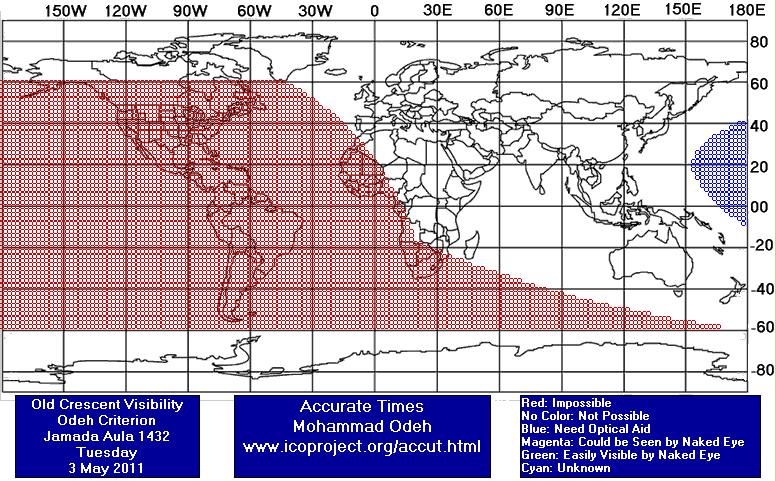
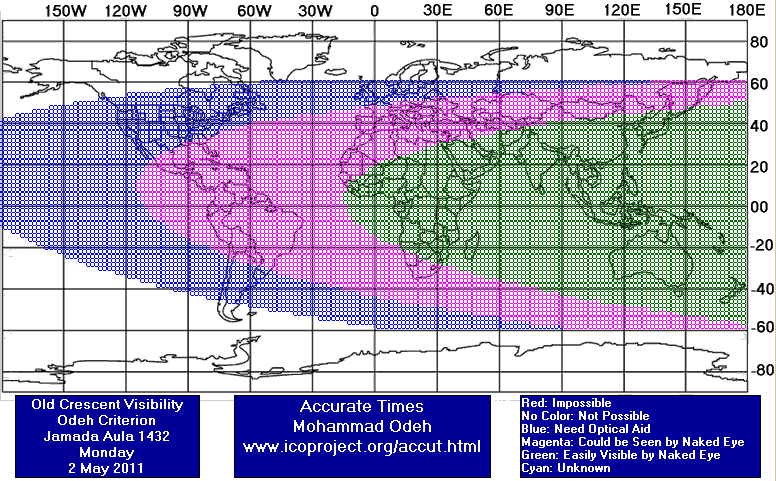
نتائج تحري هلال آخر الشهر (جمادى الأولى)
الأحد 01 مايو 2011
ألمانيا
وقال عضو المشروع المهندس مارتن إليسياسر "The crescent was easily seen with the naked eye and small binoculars, after it had risen above some low cloud layer."
المملكة المتحدة
وقال عضو المشروع المهندس قمر الدين "The eastern horizon before sunrise was totally cloudy, hence the waning crescent was not seen from York (UK)."
الإثنين 02 مايو 2011
الإمارات
وقال عضو المشروع المهندس محمد عودة "Seen by CCD imaging at: 10:26 LT (UT+4). Weather Conditions were not perfect. I'd consider it to be a little bit below the average for this area. Generally speaking, it was well below the good atmospheric conditions!"
ألمانيا
وقال عضو المشروع المهندس مارتن إليسياسر "I tried to observe the crescent during morning twilight, but did not succeed due to lots of fog, that went higher than my observation spot, a local sight-seeing tower. The upper-most layer of fog was flowing over me, but that was not good enough to see the thin crescent. The fog/clouds only resolved after noon, but a lot of haze remained and conditions weree quite bad. I could not see the crescent visually in a small telescope, so i had to resort to the imaging approach. Despite a very low contrast of less than 1% brightness increase vs. the surrounding sky and any amount of haze and flying insects and pollen and such, the crescent could be imaged and viewed on the live-screen at about 9.6° elongation from the sun. At the time of observation the old crescent was already descending again in front of the sun."
الولايات المتحدة
وقال عضو المشروع السيد جيم ستام "Old Moon Crescent Observation Report ====================================== Observed: Monday; May 02, 2011 - 05:34 (Local) Location (WGS 84) = Tucson, Arizona (USA) Longitude = 110.9651 W Latitude = 32.4206 N Elevation = 842 meters Time Zone = -7.0 hours Surface conditions at location: Temperature = 11 °C Humidity = 11 % Pressure = 30.10 in. No noticeable haze before twilight. Very slight haze at my moonrise (5° altitude). Magnitude limit at 3 degrees altitude with 55 power in C-8 telescope, before onset of twilight = 11.0 Topocentric and local time values from “Accurate Times”: Moonrise (at sea level) = 04:54 Sunrise (at sea level) = 05:32 Time from new moon at 05:15 = 19 hr. 01 min. Moon lag time = 38 min. Relative Altitude = 7.4 degrees Elongation from sun = 8.7 degrees Crescent width = 10 arc seconds Illumination = 0.6 percent I was NOT able to see the crescent, even through a telescope, with definite aim and focus. Observer: Jim Stamm E-mail Address: StammJim@gmail.com"


